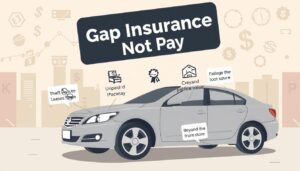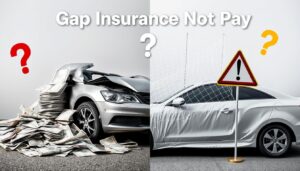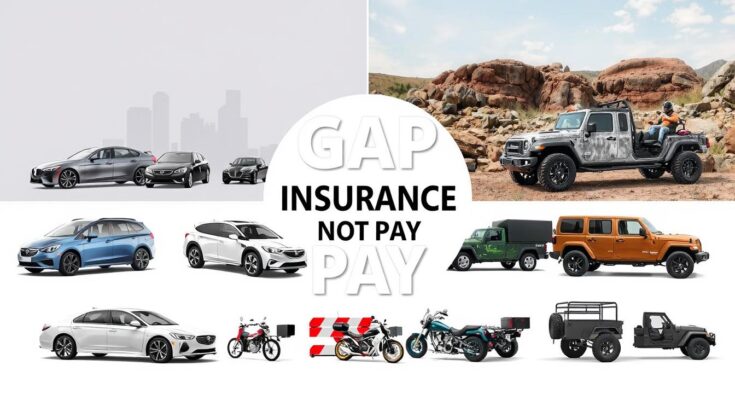Imagine buying your dream car and feeling on top of the world. But what if it gets totaled in an accident or stolen? Gap insurance offers a safety net against financial loss. Yet, it’s vital to know that gap insurance, like all insurance, has its limits and exclusions. So, the big question is: When does gap insurance not pay?
In this detailed article, we’ll dive into the main coverage limits and situations where gap insurance might not cover you. This will help you make smart choices and protect your finances fully.
Key Takeaways
- Gap insurance has specific coverage limits and exclusions that can impact its payout.
- Understanding these limitations is vital to ensure you have the right protection in place.
- Certain vehicle types, usage scenarios, and financial factors can make you ineligible for gap insurance coverage.
- Staying up-to-date on your policy and paying premiums on time are essential to maintaining gap insurance coverage.
- Discrepancies in vehicle value assessments can also lead to claim denials or reduced payouts.
Understanding the Basics of Gap Insurance Coverage
Gap insurance is a special auto coverage. It’s different from regular car insurance. While standard policies help in accidents, gap insurance covers the gap between what you owe and your car’s value.
How Traditional Auto Insurance Differs from Gap Coverage

Regular auto insurance pays for repairs or a new car if yours is damaged or stolen. But, it doesn’t consider how much a new car’s value drops right after you buy it. That’s where gap insurance helps, adding extra protection to avoid being stuck with a loan or lease you can’t afford.
The Role of Gap Insurance in Auto Protection
- Covers the gap between your car’s actual cash value and the remaining balance on your loan or lease
- Protects you from being responsible for this difference if your vehicle is totaled or stolen
- Helps you avoid out-of-pocket expenses and maintain financial stability in the event of a covered claim
Knowing how gap insurance works is key. It’s different from regular auto coverage. This knowledge helps you deal with gap insurance claim denials and policy restrictions. It helps you make smart choices about protecting your car.
Also Read: S&B Insurance – Quality Coverage You Can Trust.
When Does Gap Insurance Not Pay: Common Scenarios
Gap insurance is a valuable protection for car owners. But, it’s key to know when it won’t cover you. Knowing these exemptions can prevent surprises when you need to file a claim.
Gap insurance often doesn’t cover vehicles that are totaled in the first few months. This is because most policies have a 30-day waiting period before they start.
- Drivers who total their vehicle within the first month of purchasing gap insurance may find their claim denied.
- Similarily, if a vehicle is stolen shortly after the policy is activated, the policyholder may not receive the gap coverage payout.
Another reason gap insurance might not apply is if the car has been modified. This includes things like lift kits, custom wheels, or performance upgrades. These changes might not be covered by the policy.
| Scenario | Gap Insurance Coverage |
|---|---|
| Total loss in first 30 days | Not covered |
| Stolen vehicle within first month | Not covered |
| Vehicle modifications beyond factory specs | Not covered |
Gap Insurance Exclusions for Vehicle Types and Usage
Gap insurance is great for many car owners, but it’s not for everyone. Some vehicles and uses are not covered. Knowing this helps drivers choose the right gap insurance.
Commercial Vehicle Restrictions
Gap insurance doesn’t cover commercial vehicles like trucks and vans. These vehicles are often more valuable and depreciate differently than personal cars. So, standard auto insurance might be better for business owners.
Recreational Vehicle Limitations
Recreational vehicles, like RVs and ATVs, might not get gap insurance. They are seen as riskier and depreciate in unique ways. Owners might need special insurance for these vehicles.
Modified Vehicle Exclusions
Modified cars, with big changes from the factory, might not get gap insurance. Insuring these cars is tricky. Owners should check their policy to see if their car is covered.
Knowing when gap insurance doesn’t apply helps drivers choose the right coverage. Talking to an insurance expert can also ensure you have the right protection for your vehicle and how you use it.
| Vehicle Type | Gap Insurance Coverage |
|---|---|
| Commercial Vehicles | Typically excluded |
| Recreational Vehicles | Often excluded |
| Modified Vehicles | May be excluded |
Late Payment and Policy Cancellation Issues

Gap insurance requires timely payments and an active policy. Many face trouble when they miss a payment or their policy is canceled. This can leave them without the coverage they thought they had.
Gap insurance helps cover the gap between what your auto insurance pays and your vehicle loan or lease balance. If your policy lapses, you won’t have this protection. You’ll then be responsible for the remaining balance.
Also Read: Get Expert Broker Cargo Insurance for Your Shipments.
The Importance of Timely Payments
Make sure to pay your gap insurance on time each month. Missing a payment can cancel your policy, leaving you without protection. This is a common reason why gap insurance may not pay when you need it most.
Unexpected Policy Cancellations
Other reasons can also cancel your gap insurance policy. This includes changes in vehicle ownership, loan or lease modifications, or insurance provider errors. If your policy is canceled, gap insurance claim denials may happen if you try to make a claim.
To avoid these issues, stay alert and talk to your insurance provider often. Know your policy’s terms, set up automatic payments, and quickly fix any problems that could affect your coverage.
Non-Covered Financial Scenarios and Limitations
Gap insurance helps cover the difference between your car’s value and what you owe on it. But, it’s not perfect and has its limits.
Down Payment Related Restrictions
Gap insurance might not help if you put down a lot of money on your car. If you paid 20% or more, you might not get extra coverage. This is because a big down payment means you’re less likely to owe more than your car’s worth if it’s totaled.
Loan Balance Considerations
The amount you owe on your car also affects gap insurance. If you owe more than your car is worth, gap insurance might not cover the whole difference. This is true if your car has depreciated a lot over the years.
| Scenario | Gap Insurance Coverage |
|---|---|
| Down payment of 20% or more | Limited or no coverage |
| Loan balance higher than vehicle value | May not cover full difference |
It’s important to check your gap insurance policy’s details. Knowing what’s not covered can help you make better choices. This way, you can make sure you’re protected the way you need to be.
Time and Mileage Restrictions on Gap Coverage

Gap insurance coverage can change based on your vehicle’s age and mileage. Knowing these limits is key to using this protection wisely.
Many gap insurance policies stop covering vehicles after 6 years. This is because older cars lose value more slowly. This means there’s less gap between what you owe and what it’s worth.
- Gap insurance may not be available for vehicles older than 6 years.
- The coverage period often ends once a vehicle reaches a certain mileage threshold, such as 100,000 miles.
- Exceeding the mileage limit can void your gap insurance, leaving you responsible for the difference between your loan balance and the vehicle’s value.
Always check your gap insurance policy for time and mileage limits. Not doing so could mean losing the financial protection you thought you had.
“Gap insurance is designed to cover the gap between what you owe on your car and what it’s worth, but it’s not a one-size-fits-all solution. Understanding the limitations is key to ensuring you’re properly protected.”
Knowing the gap insurance exemptions for time and mileage helps you make better choices. This way, you won’t be surprised if something unexpected happens.
Also Read: Find Expert Insurance Solutions at Insurer Expert.com.
Claim Denial Due to Vehicle Value Discrepancies
Discrepancies in vehicle valuation often lead to gap insurance claim denials. This is a key issue for policyholders. It can greatly affect their ability to get the coverage they expect.
Market Value Assessment Problems
One main reason for claim denials is wrong market value assessments. Insurance companies use the vehicle’s current market value for payouts. This value can change a lot based on make, model, mileage, and condition.
If the insurance company’s value is far from what the policyholder thinks, the claim might be denied or only partially covered.
Depreciation Factor Impact
Depreciation also plays a big role in claim denials. Gap insurance covers the difference between the vehicle’s value and the loan balance. But, this depends on how fast the vehicle depreciates.
If the actual depreciation is more than what the insurance company expected, the gap coverage might not be enough. This could leave the policyholder with an uncovered loan balance.
| Reason for Denial | Description | Potential Impact |
|---|---|---|
| Market Value Discrepancy | Difference between insurance company’s assessment and policyholder’s understanding of vehicle value | Claim may be denied or only partially covered |
| Depreciation Rate | Actual depreciation rate higher than insurance company’s estimates | Gap coverage may not be sufficient to cover outstanding loan |
Knowing about these common issues with gap insurance claim denials is important. It helps policyholders get the coverage they need. By understanding these risks, drivers can take steps to avoid claim denials.
Insurance Company-Specific Exclusions
Gap insurance policies differ by company. Each has its own rules on what they cover. You need to check your policy carefully.
It’s important to know what’s not covered by your gap insurance. This includes non-covered scenarios and policy restrictions. If you don’t, you might face unexpected costs when you need to make a claim.
- Some insurers exclude certain vehicles, like commercial or recreational ones, from gap coverage.
- Others might not cover cars that have been modified or customized.
- Insurance companies also have rules about late payments or policy cancellations that could affect your coverage.
Knowing what your gap insurance doesn’t cover helps you make better choices. It ensures you have the right protection for your vehicle. Always check your policy details to avoid surprises later.
“Navigating the complex world of gap insurance requires attention to detail and a keen understanding of the fine print. Staying informed is the best way to ensure you’re getting the coverage you need.”
Conclusion
Understanding the limits of gap insurance is key for drivers wanting full auto protection. Gap coverage helps with the financial hit of a car’s quick drop in value. But, it’s important to know when it won’t cover as expected.
Gap insurance has rules, like not covering commercial or recreational vehicles. It also has limits on loan balances and payment history. Knowing these can help you make sure you’re fully protected in case of an accident or total loss.
Being smart about “when does gap insurance not pay” helps you make better choices. It lets you understand the gap insurance exclusions and where you might not be covered. This way, you can handle the complex world of auto insurance with confidence and peace of mind.
FAQ
What are some common exclusions or limitations of gap insurance coverage?
Gap insurance might not cover certain things. This includes vehicle modifications, commercial use, and recreational vehicles. It also doesn’t cover late policy payments or if the vehicle’s value is disputed. Always check your policy’s details.
Are there any restrictions on the types of vehicles covered by gap insurance?
Yes, gap insurance has limits for some vehicles. This includes commercial vehicles, recreational vehicles, and cars heavily modified. Coverage might be limited or not available for these vehicles.
How can late payments or policy cancellation affect gap insurance coverage?
Late payments or canceling your policy can make it void. If this happens, you won’t get coverage if you need to make a claim.
Can the vehicle’s depreciation or market value impact gap insurance payouts?
Yes, the vehicle’s value can affect payouts. If there’s a difference in how the value is assessed, you might not get the full payout. Insurers could dispute the value, leading to less or no payment.
Are there any company-specific exclusions in gap insurance policies?
Yes, each insurance company has its own rules. It’s important to read your policy carefully. This way, you’ll know what’s covered by your insurance provider.



